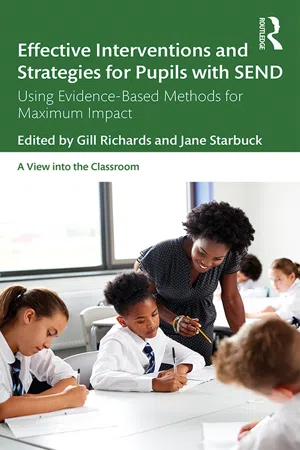
Effective Interventions and Strategies for Pupils with SEND
Using Evidence-Based Methods for Maximum Impact
- 120 pages
- English
- ePUB (mobile friendly)
- Available on iOS & Android
Effective Interventions and Strategies for Pupils with SEND
Using Evidence-Based Methods for Maximum Impact
About This Book
Effective Interventions and Strategies for Pupils with SEND offers practical, tried-and-tested strategies for supporting and championing pupils with special educational needs and disabilities. Each strategy has been researched, trialled and reviewed, with the results presented accessibly and the concerns of real teachers a key focus of the discussion.
With each chapter written by an experienced and innovative teacher working with children with SEND, this book covers a wide range of strategies for supporting pupils with SEND. These effective strategies include:
-
- Using a 'daily run' to improve concentration and behaviour
-
- Creating SEN champions and more effective teaching assistants
-
- Embedding anxiety-reducing strategies in the classroom.
Written for teachers by teachers, Effective Interventions and Strategies for Pupils with SEND is an indispensable resource for all SENCOs and other educators and staff working with children with special educational needs looking to provide the best learning experiences possible.
Frequently asked questions
Information
Chapter 1
The impact of introducing robust monitoring of interventions
Context
Strategy
- a summary of the delivery protocol for each intervention, with details on the aims of each programme
- the suggested target group, and
- further detail on the recommended length, frequency and assessment method.
Collecting evidence to measure impact
Evidence collection
| Observation framework quality features | Observed in session | Evidence |
|---|---|---|
| Are the right pupils targeted and are there clear entry and exit criteria for the intervention? | ||
| Is the location appropriate? | ||
| Is the frequency of the intervention as specified? | ||
| Is the session length as specified in the programme? | ||
| Does the session content match that specified in the programme? | ||
| Are resources pre-prepared and are well managed? | ||
| Do the adults know what the learning objectives are? | ||
| Does the pupil know what the learning objectives are? | ||
| Is the session planned and adjusted on the basis of assessment? | ||
| Do pupils help identify their own learning targets and assess their own progress? | ||
| Are key instructions and learning points given concisely and clearly and repeated as necessary? | ||
| Is behaviour well managed and does the adult promote interaction between the pupils in the group or adult? | ||
| Does the adult promote independence and help the pupil to recognise successful strategies helping them to apply them in other situations? | ||
| Does the adult create a secure and supportive environment where there is safety to ‘have a go’ and make mistakes? | ||
| Does the adult challenge the pupil and expect the most from them? | ||
| Is the session active, lively and multisensory, with sessions being well paced? | ||
| Does the class teacher review the intervention jointly? | ||
| Does the class teacher and TA have time to meet to review pupil’s progress? | ||
| Is the pupil’s progress carefully tracked? | ||
| Has there been good training for the person delivering the curriculum? | ||
| Are there opportunities for pupils to apply their learning and have it reinforced in class? | ||
| Is parental involvement secured as specified in the programme? |
Impact
Table of contents
- Cover
- Half Title
- Series Page
- Title Page
- Copyright Page
- Table of Contents
- Acknowledgements
- List of contributors
- Introduction
- 1. The impact of introducing robust monitoring of interventions
- 2. Does embedding anxiety-reducing strategies in the classroom improve behavioural and educational outcomes for children in Year 6?
- 3. A marked improvement for pupils with special educational needs and disabilities
- 4. Increasing the effectiveness of teaching assistant support
- 5. Becoming SEN champions
- 6. How does a daily run affect the concentration, attention and behaviour of children, especially those with ADHD and/or behavioural difficulties?
- 7. Moving up to ‘big school’
- 8. The impact of introducing ‘key adults’ to support children with challenging behaviour
- 9. Improving the school’s universal provision in accordance with changes outlined in the new special educational needs and disability code of practice
- 10. The impact of the Special Educational Needs and Disabilities Code of Practice: 0–25 Years on relationships between SENCOs, parents and colleagues
- Index